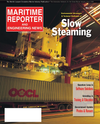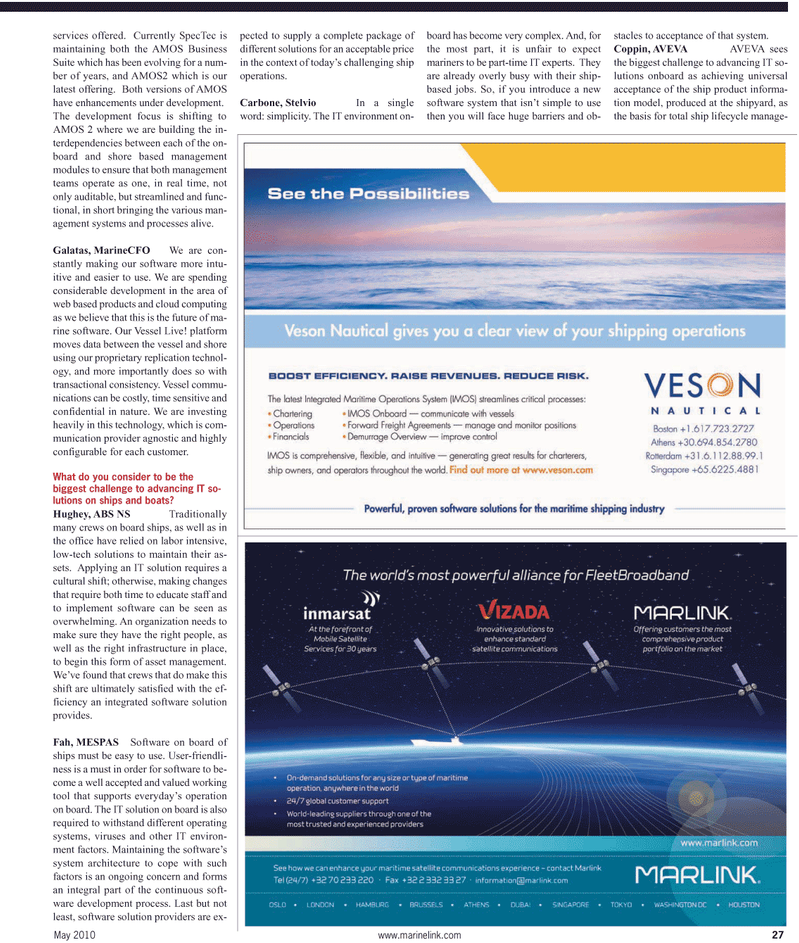
Page 27: of Maritime Reporter Magazine (May 2, 2010)
Read this page in Pdf, Flash or Html5 edition of May 2, 2010 Maritime Reporter Magazine
services offered. Currently SpecTec is maintaining both the AMOS Business
Suite which has been evolving for a num- ber of years, and AMOS2 which is our latest offering. Both versions of AMOS have enhancements under development.
The development focus is shifting to
AMOS 2 where we are building the in- terdependencies between each of the on- board and shore based management modules to ensure that both management teams operate as one, in real time, not only auditable, but streamlined and func- tional, in short bringing the various man- agement systems and processes alive.
Galatas, MarineCFO We are con- stantly making our software more intu- itive and easier to use. We are spending considerable development in the area of web based products and cloud computing as we believe that this is the future of ma- rine software. Our Vessel Live! platform moves data between the vessel and shore using our proprietary replication technol- ogy, and more importantly does so with transactional consistency. Vessel commu- nications can be costly, time sensitive and confidential in nature. We are investing heavily in this technology, which is com- munication provider agnostic and highly configurable for each customer.
What do you consider to be the biggest challenge to advancing IT so- lutions on ships and boats?
Hughey, ABS NS Traditionally many crews on board ships, as well as in the office have relied on labor intensive, low-tech solutions to maintain their as- sets. Applying an IT solution requires a cultural shift; otherwise, making changes that require both time to educate staff and to implement software can be seen as overwhelming. An organization needs to make sure they have the right people, as well as the right infrastructure in place, to begin this form of asset management.
We’ve found that crews that do make this shift are ultimately satisfied with the ef- ficiency an integrated software solution provides.
Fah, MESPAS Software on board of ships must be easy to use. User-friendli- ness is a must in order for software to be- come a well accepted and valued working tool that supports everyday’s operation on board. The IT solution on board is also required to withstand different operating systems, viruses and other IT environ- ment factors. Maintaining the software’s system architecture to cope with such factors is an ongoing concern and forms an integral part of the continuous soft- ware development process. Last but not least, software solution providers are ex- pected to supply a complete package of different solutions for an acceptable price in the context of today’s challenging ship operations.
Carbone, Stelvio In a single word: simplicity. The IT environment on- board has become very complex. And, for the most part, it is unfair to expect mariners to be part-time IT experts. They are already overly busy with their ship- based jobs. So, if you introduce a new software system that isn’t simple to use then you will face huge barriers and ob- stacles to acceptance of that system.
Coppin, AVEVA AVEVA sees the biggest challenge to advancing IT so- lutions onboard as achieving universal acceptance of the ship product informa- tion model, produced at the shipyard, as the basis for total ship lifecycle manage-
May 2010 www.marinelink.com 27

 26
26

 28
28
